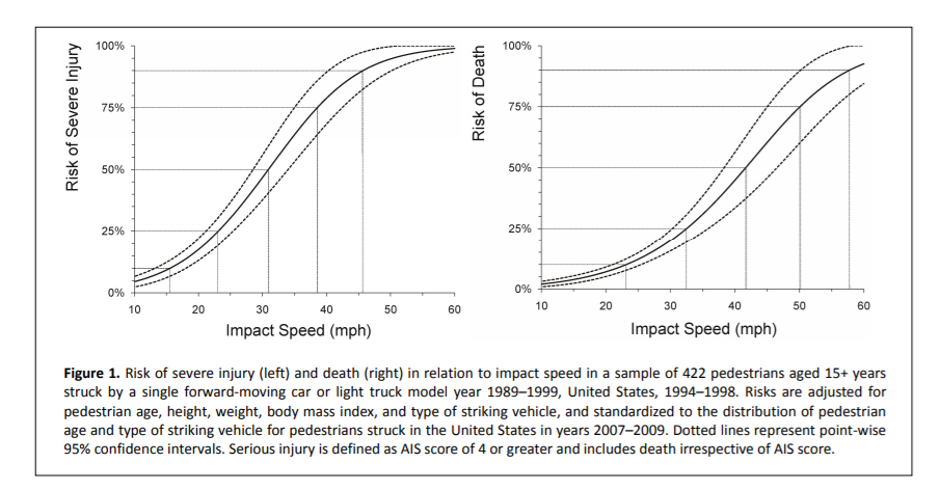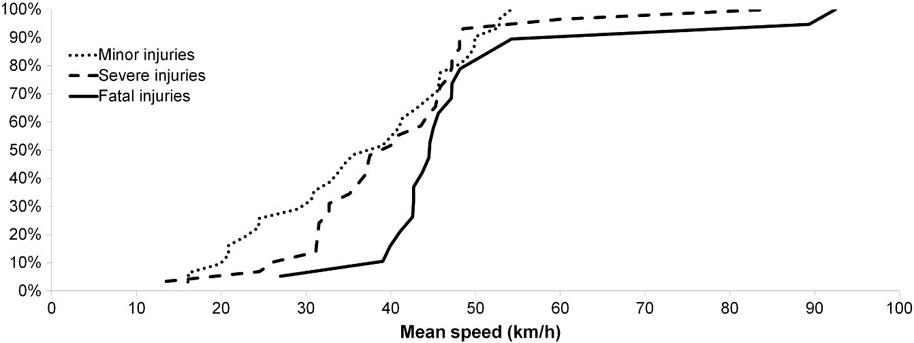The DoT in the UK publishes the following table of stopping speeds in the highway code.

The DoT probably over estimate the distance, but the relative differences at different speeds will be correct.
DoT don’t calculate stopping distances for 15mph. However based on the DoT rules we can work it out, and it’s 7.5m or 25ft.
That means a vehicle travelling at 30mph has an area in front of it 3 times the size of one travelling at 15mph that if a pedestrian enters, they will get hit. The 30mph car is travelling at twice the speed, so that area is swept in half the time. Therefore if a pedestrian randomly steps out into a road of vehicles moving at 30mph they are 1.5 times more likely to get hit than if they step into a road of vehicles moving at 15mph because of the extended braking distance.
An if they do get hit, there is plenty of data on their injury risk.
A comprehensive study by the AAA Foundation in the US measured the likelihood of death and serious injury when a pedestrian is hit at different speeds.

https://aaafoundation.org/wp-content/uploads/2018/02/2011PedestrianRiskVsSpeedReport.pdf
From the their data of 422 pedestrian collisions, the probability of being seriously injured if hit by a car or light truck goes from around 48% at 30mph, to 8% at 15mph; a 6-fold reduction in accident rates.
Coupled with 1.5 times reduction in the probability of being hit in the first place, and a 9-fold reduction in pedestrian serious injuries could be expected by going from a 30mph limit to a 15mph one.
Some pedestrians may be a hit at lower speeds than this – there is no attempt to record the vehicle speed when a pedestrian is hit in the UK. However this paper survey in Sweden found roughly 1/20th the number of pedestrian serious injuries from vehicles hit at 15mph (25km/h) as at 30mph (50km/h).

https://www.sciencedirect.com/science/article/pii/S0386111214000235
A simulated car hitting a pedestrian at 10mph looks like this.
http://videos.futuretransport.info/10mph.mp4
At 15 like this.
http://videos.futuretransport.info/15mph.mp4
At 20 like this.
http://videos.futuretransport.info/20mph.mp4
At 25 like this.
http://videos.futuretransport.info/25mph.mp4
At 30 like this.
http://videos.futuretransport.info/30mph.mp4
Note the difference between 15mph and 20mph.
If hit by a car at 20mph, a pedestrian is thrown in the air and typically land on their head.
At 15mph if hit by a car, or at 15 or 20mph if hit by an NEV, they are knocked on over on to the ground and land on their backside.
Here’s the simulated collision if they are hit by and NEV at 15mph.
http://videos.futuretransport.info/15mphgolfcart.mp4
And if they are hit by an NEV at 20mph.
http://videos.futuretransport.info/20mphgolfcart.mp4
Viewer beware — here’s dashcam footage of a real pedestrian getting hit by a car at 23mph. It’s not for the faint hearted, but if you’re a regular London motorist there is a reasonably high chance that one day you’ll see this through your own windscreen. If you’re a pedestrian, I dearly hope you never see it happen to one of your loved ones.
Watch these and then decide for yourself what speed you think drivers should be doing. We used forensic video analysis to estimate the vehicle speed at the point of impact.
http://videos.futuretransport.info/ped23.mp4
Note the severity of the impact compared to a real pedestrian being hit at 16mph (see below)
http://videos.futuretransport.info/ped16.mp4
The effect is the same as in the simulations, the pedestrian gets knocked on to the floor at 16mph and land on their backside. At 23mph they get thrown in the air and land on their head.
At higher speeds (31mph) as expected the impact is even more severe.
